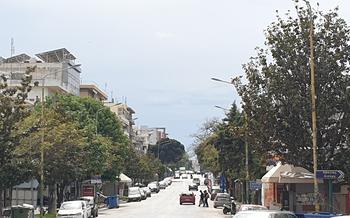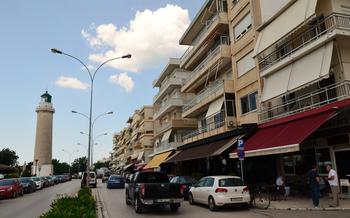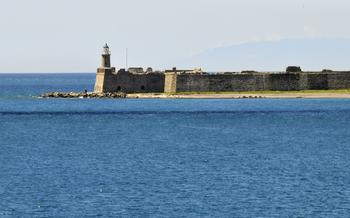
Karyofyto Wetland
- Karyofyto Lagoon: An Overview
- Exploring the Diverse Habitats:
- Birdwatching Paradise
- Rich Flora and Fauna:
- Tranquil Walking Trails
- Karyofyto Information Center
- Picnic Areas and Relaxation Spots
- Accessible for All
- Local Cuisine and Hospitality:
- Accommodation Options:
- Nearby Attractions
- Photography Opportunities
- Conservation Efforts
- Visiting Tips: Making the Most of Your Experience
- Insider Tip: Hidden Gem and Birdwatching Paradise
Karyofyto Lagoon: An Overview
Nestled in the heart of Greece's Thrace region, the Karyofyto Wetland stands as a natural treasure of immense ecological significance. This Ramsar site and Natura 2000 protected area ranks among the most important wetlands in the country. Strategically positioned at the crossroads of the Balkan and Mediterranean migration routes, Karyofyto serves as an essential stopover for numerous migratory birds. The wetland's diverse habitats, including freshwater marshes, reed beds, salt flats, and coastal dunes, support a rich tapestry of flora and fauna, making it a haven for nature enthusiasts and birdwatchers alike.
Exploring the Diverse Habitats:
The Karyofyto Wetland is a mosaic of diverse habitats, each teeming with unique flora and fauna. Freshwater marshes, characterized by shallow waters and dense vegetation, provide refuge for amphibians and reptiles like frogs, toads, and turtles. Reed beds, with their tall, slender reeds, offer nesting sites for various bird species, including the Great Reed Warbler and the Purple Heron. Salt flats, formed by the evaporation of seawater, support halophytes, specialized plants adapted to saline conditions. Coastal dunes, shaped by the wind and waves, host a variety of plant species, including the Sea Holly and the Yellow Horned Poppy. These distinct habitats create a rich tapestry of life, offering visitors the chance to observe a wide array of species in their natural surroundings.
Birdwatching Paradise
Karyofyto Wetland is a haven for bird enthusiasts, recognized as one of the most significant birdwatching destinations in Greece. The wetland's diverse habitats, ranging from freshwater marshes to coastal dunes, provide a sanctuary for a wide variety of resident and migratory bird species. Among the notable avian residents are the Dalmatian Pelican, a globally threatened species that finds refuge and breeding grounds within the wetland. The wetland also plays a crucial role as a stopover site for migratory birds, attracting species like the Glossy Ibis, the Black-winged Stilt, and the Spur-winged Lapwing. Visitors can embark on guided birdwatching tours led by experienced ornithologists, who provide insights into the wetland's rich birdlife and assist in spotting rare and elusive species. Bird hides strategically positioned throughout the wetland offer opportunities for close observation and photography, allowing visitors to capture stunning images of these magnificent creatures in their natural habitat.
Rich Flora and Fauna:
Karyofyto Wetland is not only a haven for birds but also a treasure trove of diverse plant life. The wetland's unique habitats support a rich array of plant species, including rare and protected varieties. Orchids, water lilies, and other delicate wildflowers bloom in profusion, adding vibrant colors to the landscape. The wetland's reed beds and marshes provide an ideal habitat for amphibians and reptiles, including frogs, toads, and turtles. The surrounding woodlands and scrublands are home to various mammals, including hares, foxes, and badgers. The wetland's diverse habitats make it a vital breeding ground for many species, contributing to the overall ecological balance of the region. Exploring the wetland's rich flora and fauna is a delight for nature enthusiasts, offering opportunities for wildlife photography, nature observation, and a deeper appreciation of the intricate web of life that thrives within this remarkable ecosystem.
Tranquil Walking Trails
The Karyofyto Wetland boasts a network of well-maintained walking trails that allow visitors to explore its diverse habitats at a leisurely pace. These trails meander through different sections of the wetland, providing opportunities to observe the unique flora and fauna that call this place home. Whether you're an avid birdwatcher, a nature enthusiast, or simply seeking a peaceful retreat, these trails offer a serene and immersive experience.
The trails are designed to accommodate visitors of all fitness levels, with varying lengths and difficulty levels. Some trails are short and easy, suitable for families with young children or those who prefer a leisurely stroll. Others are longer and more challenging, offering a more in-depth exploration of the wetland's hidden corners.
As you embark on your walk, pay attention to the subtle changes in the landscape. From the freshwater marshes and reed beds to the salt flats and coastal dunes, each habitat offers its own distinct charm. Keep an eye out for the diverse birdlife that frequents the area, from the elegant Dalmatian Pelican to the elusive Purple Heron.
The trails are also ideal for nature photography. With its rich biodiversity and stunning scenery, the Karyofyto Wetland provides ample opportunities to capture breathtaking images. Remember to bring your camera and binoculars to make the most of your visit.
Karyofyto Information Center
The Karyofyto Information Center serves as a gateway to the wetland's rich biodiversity and ecological significance. Situated at the heart of the wetland, the center offers an immersive experience for visitors of all ages. Interactive exhibits and educational displays provide insights into the wetland's diverse habitats, flora, and fauna. Visitors can learn about the importance of wetlands, conservation efforts, and the threats facing these fragile ecosystems. The center also features a theater that showcases documentaries and presentations on the wetland's wildlife and conservation initiatives. Guided tours led by experienced naturalists are available for those seeking a deeper understanding of the wetland's unique features. Whether you're a nature enthusiast, a birdwatcher, or simply curious about the wonders of the natural world, the Karyofyto Information Center is an essential stop on your visit to the wetland.
Picnic Areas and Relaxation Spots
As you traverse the serene paths of the Karyofyto Wetland, you will encounter designated picnic areas that beckon you to pause and savor the tranquility of nature. These inviting spots, equipped with tables, benches, and shady canopies, offer the perfect setting for a delightful al fresco lunch or a refreshing snack amidst the wonders of the wetland. Indulge in a feast of homemade delicacies, savoring the flavors of the region while immersed in the symphony of nature's sounds. Whether you choose to bask in the warmth of the sun or seek solace in the shade, these picnic areas provide an oasis of relaxation, allowing you to reconnect with the essence of the wilderness.
Accessible for All
The Karyofyto Wetland is committed to inclusivity, ensuring that visitors of all abilities can enjoy the beauty and wonders of the natural world. Wheelchair-accessible paths and boardwalks have been thoughtfully constructed throughout the site, allowing individuals with mobility challenges to navigate the diverse habitats with ease. Special facilities and considerations have been implemented to cater to visitors with disabilities, promoting an environment where everyone feels welcome and respected. Comprehensive accessibility information is readily available on the wetland's website, empowering visitors to plan their visit with confidence.
Local Cuisine and Hospitality:
The warmth of Greek hospitality extends to the culinary scene near the Karyofyto Wetland. Indulge in the region's traditional cuisine, where fresh seafood takes center stage. Savor the flavors of grilled octopus, tender calamari, and succulent shrimp, all caught from the nearby Aegean Sea. Local tavernas serve up authentic Greek dishes using fresh produce and regional specialties. Try the flavorful moussaka, succulent souvlaki, and aromatic pastitsio, all bursting with Mediterranean flavors. Experience the essence of Greek cuisine while enjoying the convivial atmosphere and warm hospitality of the local community.
Accommodation Options:
The vicinity of Karyofyto Wetland offers a range of accommodation options to suit diverse preferences and budgets. For a comfortable stay, visitors can choose from hotels and guesthouses that provide modern amenities and warm hospitality. Those seeking a more immersive experience can opt for traditional lodgings like farmhouses or guesthouses, which offer a glimpse into the local culture and way of life.
Proximity to the wetland is a key consideration when choosing accommodation. Many hotels and guesthouses are conveniently located within walking distance or a short drive from the wetland's entrance, allowing for easy access to its trails and wildlife.
To make the most of your stay, consider your budget, preferred level of comfort, and desired proximity to the wetland. Whether you seek a luxurious hotel experience or a cozy traditional lodging, you'll find suitable options near Karyofyto Wetland, ensuring a comfortable and enjoyable stay while exploring this natural treasure.
Nearby Attractions
Beyond the natural wonders of Karyofyto Lagoon, the region offers an array of cultural and historical attractions. Immerse yourself in the rich heritage of the area by visiting the ancient city of Maroneia, just a short distance from the wetland. Explore the well-preserved ruins of this once-thriving settlement, including its impressive fortifications, temples, and theater.
Head to the nearby town of Komotini, the capital of the Rhodope region, to experience a vibrant blend of cultures. Stroll through the charming old town, where Ottoman-era architecture seamlessly merges with modern influences. Visit the Archaeological Museum of Komotini to delve into the region's rich history, showcasing artifacts from prehistoric times to the Byzantine era.
For a scenic escape, drive along the picturesque Nestos River, which meanders through lush landscapes and traditional villages. Admire the stunning Nestos Gorge, with its towering cliffs and cascading waterfalls. Take a break to swim in the refreshing river waters or embark on a thrilling rafting adventure.
If you're drawn to coastal beauty, head to the nearby Nea Peramos Beach, known for its pristine waters and golden sands. Enjoy a relaxing day sunbathing, swimming, or indulging in water sports like windsurfing and kitesurfing.
Combine your visit to Karyofyto Lagoon with these diverse attractions to create a well-rounded travel experience that encompasses nature, history, and culture, ensuring unforgettable memories in this captivating region.
Photography Opportunities
The Karyofyto Wetland is a haven for nature and landscape photographers, offering a wealth of opportunities to capture stunning images. The diverse habitats, abundant wildlife, and picturesque landscapes provide a perfect backdrop for photography enthusiasts.
Photographers can capture the vibrant colors and intricate patterns of the wetland's flora, from the delicate orchids and water lilies to the lush reed beds and salt flats. The wetland's diverse wildlife also presents excellent photographic subjects, from the graceful Dalmatian Pelicans and other migratory birds to the elusive amphibians, reptiles, and mammals that call the wetland home.
To make the most of your photography experience, consider using a telephoto lens to capture close-up shots of wildlife, a wide-angle lens to capture the vastness of the landscape, and a tripod to ensure stability. The early morning and late evening hours offer the best lighting conditions for photography, as the warm, golden light casts a magical glow over the wetland.
For those interested in learning more about photography in the Karyofyto Wetland, workshops and photography tours are available, led by experienced photographers who can provide guidance on equipment, timing, and composition. These tours offer a unique opportunity to learn from experts and capture exceptional images of the wetland's beauty.
Conservation Efforts
The Karyofyto Wetland is under the watchful eye of dedicated local organizations and environmental groups who tirelessly work to protect and preserve its natural wonders. These organizations conduct extensive research, monitoring, and habitat restoration projects to ensure the wetland's long-term health. Educational programs and awareness campaigns are organized to engage visitors and the local community, fostering a sense of responsibility and stewardship towards this unique ecosystem. Visitors can contribute to these conservation efforts by following responsible wildlife viewing guidelines, minimizing their impact on the environment, and supporting local initiatives. Together, we can ensure that the Karyofyto Wetland remains a thriving haven for wildlife and a source of inspiration for generations to come.
Visiting Tips: Making the Most of Your Experience
Timing is Everything: For the ultimate wildlife viewing experience, plan your visit during the spring or fall migration seasons, when the wetland buzzes with activity. In spring, witness the arrival of numerous bird species seeking breeding grounds, and in autumn, observe the spectacular departure of migratory birds embarking on their long journeys south.
Dress for the Occasion: The wetland's diverse terrain demands appropriate attire. Comfortable walking shoes or hiking boots will allow you to navigate the trails with ease, while long-sleeved shirts and pants will protect you from insects and vegetation. Don't forget a hat, sunglasses, and sunscreen to shield yourself from the sun's rays.
Essential Gear: Enhance your wetland experience by packing a few essential items. Bring binoculars or a spotting scope to get closer views of birds and wildlife. A camera will help you capture the beauty of the landscape and its inhabitants. Don't forget a notebook and pen to jot down your observations or sketch the stunning scenery.
Respecting the Environment: As visitors to this delicate ecosystem, it's crucial to minimize our impact on the environment. Stay on designated trails to avoid disturbing wildlife and damaging sensitive habitats. Refrain from littering and dispose of waste responsibly. Observe wildlife from a distance and avoid loud noises that might disrupt their natural behavior.
Ethical Wildlife Viewing: Embrace responsible wildlife viewing practices to ensure the well-being of the animals you encounter. Avoid approaching wildlife too closely, as this can cause stress and disrupt their activities. Use binoculars or a telephoto lens to get closer views without disturbing them. Refrain from feeding wildlife, as this can alter their natural behavior and make them dependent on humans.
Insider Tip: Hidden Gem and Birdwatching Paradise
For a truly unique experience, venture off the beaten path to discover a secluded birdwatching spot within the wetland. Look for a small, hidden marsh nestled among the reeds, where you can observe a variety of waterbirds up close. This tranquil haven is home to nesting herons, egrets, and other shy species that prefer the seclusion of this undisturbed area. Remember to bring your binoculars and a camera to capture the beauty of these elusive birds in their natural habitat.



